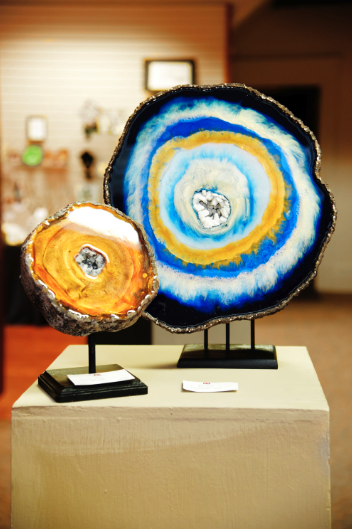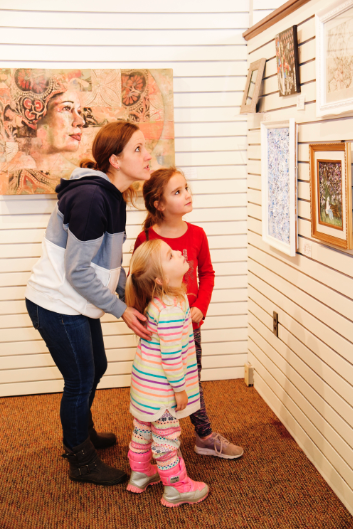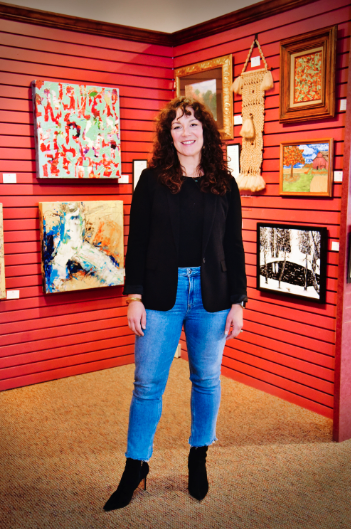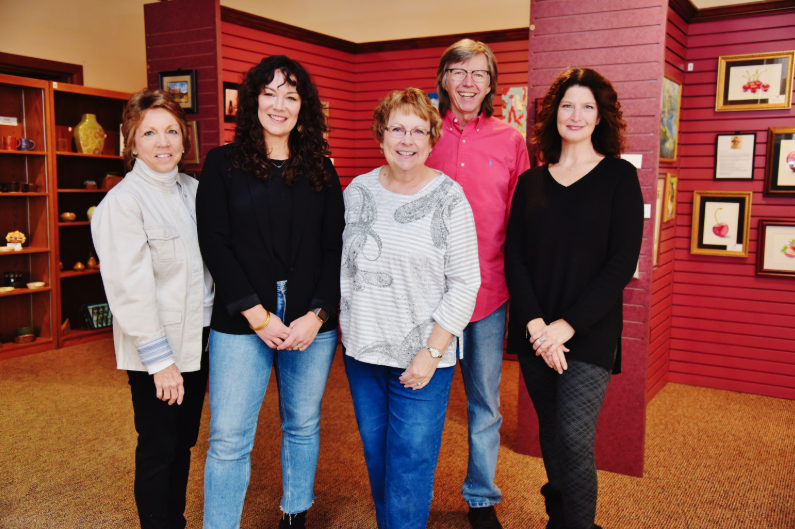An Art Revolution Bringing Culture to Small-Town America
Photographer / Jubilee Edgell
 It doesn’t take an aesthete to appreciate the bright, airy Heartland Gallery on the corner of Michigan and LaPorte in Plymouth with its alcoves tastefully arranged with pieces by local creatives. It doesn’t take an enthusiast to be impressed by the display of brochures right inside the front door, all about the different art classes offered at the establishment. It doesn’t take an artist to discover that the docent behind the counter is a creative in their own right and loves working at the gallery. It doesn’t take an artist — but to create this kind of atmosphere, it takes a passionate community, one that strongly believes in the power and importance of art in small-town America.
It doesn’t take an aesthete to appreciate the bright, airy Heartland Gallery on the corner of Michigan and LaPorte in Plymouth with its alcoves tastefully arranged with pieces by local creatives. It doesn’t take an enthusiast to be impressed by the display of brochures right inside the front door, all about the different art classes offered at the establishment. It doesn’t take an artist to discover that the docent behind the counter is a creative in their own right and loves working at the gallery. It doesn’t take an artist — but to create this kind of atmosphere, it takes a passionate community, one that strongly believes in the power and importance of art in small-town America.
To the movers and shakers around Plymouth in the late 1970s, a display of the arts was nothing short of a cultural must. A club of artists and appreciators met regularly in Herb Eveland’s art classroom in the high school to enjoy art and solidarity as the group grew.
“I think when they started, they had no idea that it was going to continue for so long and grow so much,” says former president and long-time member, Jayne Jacobson. “I think we just sort of thought, ‘Well, here’s a group of people now who are interested. Let’s get together.’”
By 1984, the club was ready to form an official art association who met not only to enjoy art but also to bring it to the community in the form of annual art shows around town, at places like the public library and Ancilla College, among many others. For 15 years, they displayed their works at various local establishments until they finally found a place of their own in the downtown area around the early 2000s.
Founding member and former president, Ed Pullen, vividly remembers those days. The idea to found an art gallery was originally his. As someone who lived in several cultural centers around the nation before settling in Plymouth, his reason was quite simple: “Plymouth needs an art gallery. Without an art gallery, a town is just a truck stop.”
Having a physical location was an incredible milestone for them, but it came business overhead. It didn’t take long until the bottom line was nearly the demise of the gallery.
“We were totally broke. I paid the bills out of my pocket to keep us open,” Pullen says.
Over the next decade, the association rented several different spaces downtown. The turning point came when local business owner and arts supporter, Susan Fortin, approached them about moving to their current location.
“I said, ‘We are so broke right now, we can’t even look at anything we need to pay rent for,’” remembers Jacobson.
However, Fortin was correct — the location was perfect for a gallery. So, Pullen and Jacobson asked the city for help. After meeting with the mayor, they received a $5,000 annual stipend — much more than they had imagined.
“She and I walked out and we were this high off the ground,” Pullen holds his hand three feet from the floor, grinning from ear to ear.
That was in 2013. In the last six years, they’ve seen an explosion of growth. Currently, they have more than 80 members and pull artists from all around Marshall County and beyond.
 “We have anything from photography to watercolors, acrylics and oils, to pastels and fiber and textile art. We also have ceramics, pottery, jewelry, glass, stained glass, resin,” says current president Anna Kietzman. “We’re always looking for those new artists to come in.”
“We have anything from photography to watercolors, acrylics and oils, to pastels and fiber and textile art. We also have ceramics, pottery, jewelry, glass, stained glass, resin,” says current president Anna Kietzman. “We’re always looking for those new artists to come in.”
One of their most obvious purposes is to help artists sell their work — not only in the gallery itself but also at various shows and exhibitions across the county. But their purpose goes a lot deeper than just providing an outlet for creatives.
“Artists can’t be supported fully if they aren’t viewed as professionals,” Kietzman says. “It’s one thing if our artists voluntarily donate their work, but if we keep doing that, what does that do for artists all around? It undermines them. It undermines their work, their time, them as professionals in the workforce. That comes down to the crux of our mission: we are supporting local art and artists. We have an important job to do, and that is to reshape some of these perspectives, not just with challenging them with what art they see but also people need to respect an artist and what it is that they do.”
However, to assume that the Heartland is only a haven for artists would still be to miss their ambition to see art on the streets of Plymouth and beyond.
“We know at least anecdotally that the programs that we have — the influence we have — is having an impact on the community,” Kietzman says. “We know what having art does for a community, but to have an actual organization, a place where people know they can go, is incredibly important.
“Everyone wants art. They want that in their town and community. They want it in their lives. But a lot of folks don’t know how to go about doing that. And that’s what we are. We are more than a gallery. The gallery is an important part of who we are, but ultimately, we are a visual arts organization and we have many programs that extend outside of the gallery itself.”
Some of those programs are art classes for children and adults alike. Other programs are the result of strong, symbiotic partnerships with other businesses and organizations around town that are focused on beautifying places of business and even Marshall county itself with murals, banners and other kinds of art.
“If there’s anything anyone wants in the city,” says head marketer Shelley Heiden. “We’ve become that place that’s the incubator of all the arts. The city knows it and uses it, which helps us thrive.”
The leadership of the organization never takes for granted the uniqueness of their situation, especially since larger communities, like South Bend, have tried and failed to establish a gallery like the Heartland.
“I guess there are two main differences. One is that we really have the support of our community,” Jacobson says. “The other thing is that we have a lot of volunteer hours from our members. A lot of other places don’t have that.”
Those volunteer hours mean the difference between success and failure for the gallery. They have no paid employees, even on the executive board.
Part of the sheer number of volunteer hours the gallery receives is because the basic membership package requires it. But members aren’t limited to working behind the counter. There are nine different committees that members can serve on, each that shapes and serves the gallery. However, the real reason behind the volunteering is because the members believe in the Heartland Gallery and the causes it represents.
Since the artists and art appreciators who volunteer at the gallery also have other jobs, it’s not uncommon that they inadvertently advertise for the gallery during their day job. One case-in-point is Jon Miller, who is the vice president and a popular art instructor.
“He’s a hair-dresser and he is booked up all the time because he has a following there as well. He brings a lot of those to his classes and vice versa,” Kietzman says.
 Every month, the gallery has a show or event. This month, the gallery is featuring regional artist Avon Waters and his beautiful pastels. However, the gallery’s main events happen in March, May, June and October. In March, the association is proud to present its annual National Youth Art Month Exhibit, which features art done by local K-12 students, which brings families into the galleries.
Every month, the gallery has a show or event. This month, the gallery is featuring regional artist Avon Waters and his beautiful pastels. However, the gallery’s main events happen in March, May, June and October. In March, the association is proud to present its annual National Youth Art Month Exhibit, which features art done by local K-12 students, which brings families into the galleries.
The gallery holds two juried art shows every year, both of which are organized by the Heartland’s curator, Carrolyne Babcock. The first one is in May when the gallery puts on their Small Wonders Art Exhibit. For this event, all art pieces must fit within a 12-by-12 inch format.
“I’ll tell you what, you bring that artwork in and there are a couple of rulers setting out and they are evaluated to the millimeter,” Kietzman says. “It’s a hoot to watch.”
In June, the association hosts its Art in the Street Festival.
“I think we started out on the sidewalks with six vendors,” Kietzman says. “I think we had 36 or 37 art vendors and an additional 10 or so kids’ booths, and I think we had more than 1,000 attendees last year.”
Their largest one is in October and showcases the best and brightest artists, drawing from northern Indiana and even from out-of-state. Several awards are given out at this show, one of which is chosen by popular vote at the end of the show.
As the Heartland Artists Gallery looks to the future, they believe that their influence will continue to grow, expanding until they become an art-stop between Chicago, Detroit, Fort Wayne and Indianapolis.
They also are looking forward to developing an unofficial art block with Wild Rose Moon, the Rees Theater, and hopefully others.
“[They] support us, and we support them,” Jacobson says. “I think that’s the way it is throughout our community, which is a strength. We could very easily be more insular and isolationist here, but it’s fun working together.”
Heartland Gallery is located at 101 N. Michigan St. in Plymouth. A full list of their 2020 events and more information about their art classes can be found online at heartlandartgallery.com. To contact them, email them at heartlandartistsgallery@gmail.com or call them at 574-936-9515.






